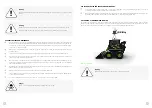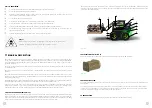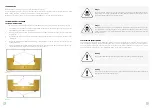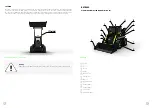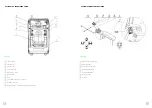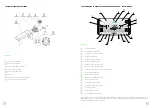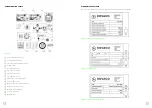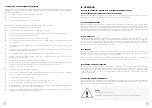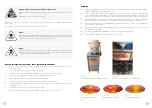
51
50
9.3 CHECKS AND ACTIONS BEFORE COMMISSIONING
Damage to the loader or attachment (optional equipment) can lead to unpredictable and dangerous situations. If you notice
any damage or other fault of the loader or attachment during the following checks, the loader must not be used until all the
defects have been removed.
Do not remove, disable or turn off safety devices or switches.
Do not change predefined setpoints.
Do not use the loader until it has been properly repaired.
Before putting the loader into operation, make sure that its safe operation is guaranteed:
The boom and bucket arms must not be visibly damaged.
The locking device of the attachment must not be damaged or deformed.
Any other accessories as well must not show any visible damage (such as bends, cracks, significant wear).
The pins must be properly lubricated and inspected.
The space under the loader must be checked for leaks of working fluids.
The protective grilles (optional equipment) and the driver’s protective roof must not be damaged and must be
roperly fastened.
The attachment (optional equipment) must be correctly fastened and must operate in accordance with the operat-
ing instructions.
All information labels must be affixed in place and legible. Damaged or missing labels must be replaced according
to indications in the chapter "Identification Points".
All warning devices (such as the warning horn) must be in perfect condition and fully functional.
Make sure to check for damage and leaks in visible parts of the hydraulic system and the hydraulic oil tank.
Damaged hoses must be replaced.
The batteries must be located securely in the battery compartment.
The battery plug must be inspected for damage (e.g. cracks, fissures or housing deformation, bending or damage
to contacts). If necessary, the battery plug must be replaced in an authorized service center.
The battery cover must be securely closed.
The battery lock must not be damaged or deformed.
The base frame of the battery, the battery compartment and the battery cover must not be damaged or deformed.
The service covers must be closed and the cabin safety locks secured.
The cabin steps must be clean and ice-free.
The cabin locks and their locking pins must be secured before using the machine.
All glass surfaces (such as the front windscreen) must be clean and ice-free.
Depending on the tyres, the loader can be equipped with an antistatic belt. The antistatic belt must not be damaged.
Further it must be clean and long enough to touch the ground.
Damage to or other defects of the loader including attachment (special equipment) must be reported immediately
to the operator do that the fault can be rectified by the same.
10. OPERATION
10.1 OPTIMUM OPERATING CONDITIONS TO CONSERVE THE BATTERY CAPACITY
10.1.1 BATTERY CAPACITY INDICATOR: THE DISPLAY BACKLIGHT
When working with the Elise 900 loader, it is very important to monitor the machine load or the power intake from the loader
battery. For this, the power intake indicator is used in the Kovaco application on the phone.
10.1.2 RECOMMENDED SPEEDS
When working with the loader with the basic shovel, we recommend setting the machine’s travel speed to 2 and hydraulic
speed to 3. For fine handling of heavy objects when loading or unloading, the recommended settings are travel speed 1
and hydraulic speed 1. Travel speed 1 and hydraulic speed 1 also are recommended for connecting attachments. For other
types of work with the loader, the settings must be done and adjusted according to the type of task at hand. As a rule when
working with the loader, the lower the speed, the more substantial savings on battery capacity.
10.1.3 DRIVING STYLE
The battery capacity is significantly affected also by the actual driving style. As far as the situation allows it, it is recom-
mended to turn with the machine in a style around the entire radius, that is, with the wheels on one side of the loader not
moving, or moving at low speed, and rotating on the other side of the machine. In this way, the loader turns economically.
It is uneconomical to turn around the axis, which is with the wheels on each side moving in the opposite direction from the
other side. This will result in a sharp drop in battery capacity.
10.1.4 SURFACE
The surface on which the loader operates also greatly affects the battery capacity. The loader has rough-terrain tyres
mounted as a factory standard, specifically tyres with a sparse and high tread pattern. However, this tyre is not suitable
for tarmac or concrete as it is soft, has great rolling resistance and it slips.
Where the machine is expected to operate mostly on paved surfaces such as tarmac or concrete, it is recommended
to equip the loader with tyres for paved surfaces to avoid heavy draw on the battery and severe tyre wear.
10.1.5 TURNING OFF BUCKET LEVELLING
Moderate savings on battery capacity can also be obtained by disabling bucket levelling. This function mainly is used
for working at more elevated heights. This means working above the vehicle operator’s cabin, where visibility of the work
device is impaired. The higher draw on the battery is due to the fact that the hydraulic pump has to run at a higher output
in order to be able to supply oil to two sections of the distributor simultaneously. Therefore, when levelling is on, the boom
speed also is slightly lower.
10.1.6 HEATING AND AIR-CONDITIONING
The use of heating and air-conditioning also has a significant effect on the battery capacity. For loaders with an internal com-
bustion engine, the use of air-conditioning results in an increase in the machine power consumption by up to 10%. Similarly,
it also reduces the battery capacity of the electric machine.
!
Warning
Risk of damage to components!
A deformed or damaged battery plug may cause overheating and subsequent damage.
Содержание Elise900
Страница 1: ...Elise900 User Manual for Operation and Maintenance ...
Страница 2: ...KOVACO Electric a s 1st edition 2020 ...
Страница 44: ...Elise900 Manual for the Kovaco Application ...
Страница 50: ...NOTES NOTES ...
Страница 51: ...COPYRIGHT KOVACO Electric a s All rights reserved ...







